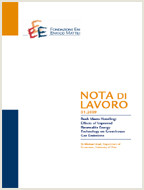The Fight Against Geography: Malaria and Economic Development in Italian Regions

06.01.2011
Marco Percoco
J100, N300, O100, R100
Geography, Regional Growth, Malaria
Economy and Society
Gianmarco I.P. Ottaviano
Geography has long been considered as a fundamental prerequisite for economic development and growth. In recent years, a growing number of papers have considered the role of physical geography as a determinant of regional growth and development by considering it as a source of “intrinsic advantage”. Malaria is considered to be strictly related to poverty and its geographically-related origin is now widely recognized, i.e. it is endemic only in certain areas of the globe whose environmental and climatic characteristics are ideal for the proliferation of mosquitoes which are the vector for the transmission of the disease. The World Health Organization is currently setting a series of policies aiming to eradicate the disease from Africa, with the specific goals to preserve human lives and possibly to boost economic growth in those areas. Among the several malaria parasites, the worst, Plasmodium falciparum, has infested Italian regions for centuries until the complete eradication occurred in the period 1945-1950. In this paper I provide an empirical assessment of the economic outcomes of malaria eradication in Italian regions. By making use of both macroeconomic and microeconomic data, I found support to the hypothesis that malaria eradication boosts productivity growth and that in the long run it leads to an increase in human capital. In particular, I found that the presence of malaria reduced significantly regional growth over the period 1891-1961, while its eradication increased the years of schooling for both males and females respectively, although my evidence points at a larger support for a very long run impact of eradication actions through an intergenerational spillover effect.
